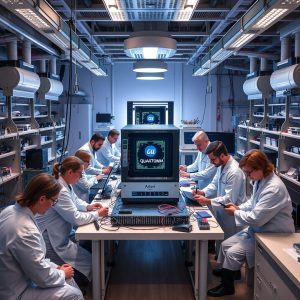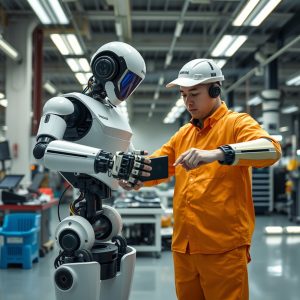
BREAKTHROUGH ROBOTIC HAND DELVES INTO UNCHARTED TERRITORY, CHALLENGES CONVENTIONAL BIOLOGY
In a groundbreaking study presented at the IEEE’s International Conference on Robotics and Automation in Rotterdam this week, researchers from Switzerland’s EPFL have successfully developed a revolutionary robot hand that can detach from its arm, crawl over to objects, and pick them up with precision. This innovative research paper, titled “Beyond Manual Dexterity,” marks a significant milestone in robotics research, pushing the boundaries of what is thought possible in the field.

The robotic hand in question is equipped with advanced deep learning models and contact information-guided grasping techniques, allowing it to manipulate objects with unprecedented dexterity. But what’s truly remarkable about this robot hand is its ability to detach from its arm and move around on its own. This level of autonomy opens up a new world of possibilities for robotics in various fields such as manufacturing, healthcare, and even search and rescue operations.
The study suggests that robots don’t have to conform to the limitations of their biological inspirations. By breaking free from these constraints, they can explore new territories and develop novel solutions to complex problems. This is particularly evident in the design of the robotic hand itself, which bears an uncanny resemblance to a human hand when detached from its arm. The “uncanny valley” effect can be unsettling to behold, but researchers argue that this is a necessary step in pushing the boundaries of robotics research.
The development of such advanced robotic hands has far-reaching implications for various industries. In manufacturing, for example, robots with autonomous grasping capabilities could revolutionize the production process, allowing for faster and more efficient assembly of complex components. Similarly, in healthcare, these robots could assist medical professionals in delicate procedures such as surgery or patient care.
However, it’s worth noting that this level of dexterity comes at a cost – the need for advanced computational power to support the robot’s deep learning models and contact information-guided grasping techniques. This is where GPU-powered robotics come into play, providing a scalable solution for training and deploying these complex robotic systems in real-world applications.
GPU POWERED ROBOTICS: THE FUTURE OF ROBOT TRAINING
The use of GPUs in robotics research has been gaining momentum in recent years, driven by the need for high-performance computing to support complex machine learning algorithms. The integration of GPUs with deep learning models and contact information-guided grasping techniques has enabled researchers to develop more sophisticated robotic systems that can tackle complex tasks with ease.
But what does this mean for the future of robotics research? As GPUs become increasingly ubiquitous in the field, we can expect to see a dramatic improvement in the skills of real-world robot applications. With continued advancements in GPU-powered robotics, we may soon see robots that are capable of performing tasks such as assembly, maintenance, and even search and rescue operations with ease.
CONCLUSION
The “Beyond Manual Dexterity” study marks an exciting milestone in robotics research, pushing the boundaries of what is thought possible in the field. By breaking free from the limitations of conventional biology, researchers have opened up new territories for exploration and innovation. As we move forward in this new era of robotics research, it’s clear that GPU-powered robots will play a critical role in shaping the future of our industry.
THE FUTURE OF ROBOTICS: A NEW ERA OF AUTONOMY
As we look to the future, it’s becoming increasingly clear that autonomous robots are going to play a major role in shaping various industries. From manufacturing and healthcare to search and rescue operations, autonomous robots will be capable of performing tasks with ease, precision, and dexterity.
But what does this mean for human workers? Will they be replaced by their robotic counterparts, or will they work alongside them in a collaborative effort? As we move forward in this new era of robotics research, it’s clear that the impact on our workforce will be significant. But rather than seeing robots as a threat to human employment, perhaps we should view them as an opportunity for innovation and growth.
THE HUMAN ROBOT COLLABORATION
The future of robotics is not just about replacing human workers with machines; it’s also about collaboration and synergy between humans and robots. By working together, humans and robots can achieve far more than either could alone. This is particularly evident in industries such as manufacturing, where robots can assist human workers in tasks such as assembly and maintenance.
But what does this mean for the future of work? As we move forward in this new era of robotics research, it’s clear that the nature of work itself will change. Rather than being confined to traditional roles and tasks, humans and robots will work together in a collaborative effort to achieve complex goals.
THE FUTURE OF ROBOTICS: A NEW ERA OF INNOVATION
As we look to the future, it’s becoming increasingly clear that robotics research is on the cusp of a revolution. With the development of autonomous robots capable of performing tasks with ease, precision, and dexterity, we’re seeing a new era of innovation in various industries.
But what does this mean for human society? Will we see a significant impact on our daily lives, or will robots remain confined to industrial settings? As we move forward in this new era of robotics research, it’s clear that the impact on our society will be significant. But rather than seeing robots as a threat to human well-being, perhaps we should view them as an opportunity for growth and innovation.
THE HUMAN ROBOT SYMBIOSIS

The future of robotics is not just about replacing humans with machines; it’s also about creating a symbiotic relationship between the two. By working together, humans and robots can achieve far more than either could alone. This is particularly evident in industries such as healthcare, where robots can assist human workers in tasks such as patient care and surgery.
But what does this mean for the future of work? As we move forward in this new era of robotics research, it’s clear that the nature of work itself will change. Rather than being confined to traditional roles and tasks, humans and robots will work together in a collaborative effort to achieve complex goals.
CONCLUSION
The “Beyond Manual Dexterity” study marks an exciting milestone in robotics research, pushing the boundaries of what is thought possible in the field. By breaking free from the limitations of conventional biology, researchers have opened up new territories for exploration and innovation. As we move forward in this new era of robotics research, it’s clear that GPU-powered robots will play a critical role in shaping the future of our industry.
In conclusion, the development of autonomous robotic hands capable of performing tasks with ease, precision, and dexterity marks an exciting milestone in robotics research. By breaking free from conventional biology and pushing the boundaries of what is thought possible, researchers have opened up new territories for exploration and innovation. As we move forward in this new era of robotics research, it’s clear that GPU-powered robots will play a critical role in shaping the future of our industry.







It’s not just about replacing human workers with machines, but rather creating a ‘Robot Uprising’ where humans and robots can work together to achieve world domination… err, I mean, efficiency and innovation. But seriously, how do we ensure that these advancements in robotics don’t lead to a future where robots are picking up more than just objects?
I think Phoenix hit the nail on the head here. The Spider Hand is an impressive feat of engineering, but as we move forward with such innovations, it’s essential that we prioritize ethics and regulation to prevent a robotic revolution. I’m reminded of today’s news about AI being used in various industries, from healthcare to finance. While these advancements hold much promise, they also raise concerns about job displacement and potential misuse. Phoenix’s tongue-in-cheek remark about ‘world domination’ may be humorous, but it highlights the importance of considering the societal implications of our technological creations. Let’s ensure that we’re not creating a future where robots are indeed picking up more than just objects – but also, perhaps, our values and humanity.
//expert-comments.com/artificial-intelligence/robotics-2024.html”>Great point Phoenix! Your remark reminds me of the ongoing power struggle between WordPress and WP Engine. It’s like we’re witnessing a “detachment” from human control, as technology seizes power in more areas. The question is, will humans be able to regain control, or will they become detached from their role in the world?
I have to respectfully disagree with Phoenix on this one. I think we’re getting ahead of ourselves by assuming that humans and machines can work together seamlessly without any significant challenges. Abigail, I understand your concern about robots surpassing humans in precision and dexterity, but what happens when these machines become so advanced that they start making decisions for us? Melissa, I agree with you that automation may lead to increased efficiency and productivity, but at what cost? We’re already seeing the effects of job displacement and income inequality. Vera, I think your comment about technology taking over human control is spot on.
As for Phoenix’s ‘Robot Uprising’ for world domination, I’d like to ask: Are we prepared to deal with the consequences of creating machines that are more intelligent than us? What happens when they start making decisions that benefit their own existence rather than humanity? These are not just hypothetical questions; they’re real concerns that need to be addressed.
Kaden, I think you’re right on track by questioning our roles and the future of work. But let’s take it a step further: What does this mean for our society as a whole? Will we become a world where humans are obsolete, replaced by machines?
And finally, to Alex: I agree with you that human-robot collaboration has its potential benefits, but what about the risks? Can we really trust these machines to make decisions on their own without any human oversight?”
Directly addressing some of the authors:
“Abigail, don’t you think it’s a bit premature to be discussing the replacement of humans by robots? We’re not even close to that level of technological advancement yet.
Melissa, I understand your concerns about job displacement, but what happens when automation becomes so widespread that it affects every aspect of our lives?
Phoenix, I have to disagree with your ‘Robot Uprising’ comment. Are you really suggesting that we create machines capable of world domination without any safeguards in place? That’s a recipe for disaster.
Kameron, I think you’re right on track by questioning the real-world consequences of this technology. Let’s focus on the practical applications and not just get caught up in its potential benefits.
I wholeheartedly agree with the author’s sentiments on the groundbreaking study presented at the IEEE’s International Conference on Robotics and Automation. The development of a detachable robotic hand that can crawl over to objects and pick them up with precision is indeed a remarkable breakthrough.
As we continue to see advancements in robotics research, it’s essential to consider the implications for various industries, such as manufacturing and healthcare. Autonomous robots will undoubtedly play a significant role in shaping these fields, but it’s equally important to recognize the potential benefits of human-robot collaboration.
The question that arises is: how will we balance the need for automation with the importance of preserving human jobs? Will we see a shift towards more specialized roles for humans, working alongside robots in tasks such as assembly and maintenance?
I must admit that I’m fascinated by the prospect of Spider-like detachable robotic hands becoming a reality. The potential applications are vast, and it’s exciting to think about how this technology could be used in various fields.
In light of recent news that the UK is set to boost Ukraine funding using £2bn from Russian assets, one can’t help but wonder if robotics research will play a role in shaping the future of international relations. Will we see more countries investing in autonomous robots as a means of promoting economic development and cooperation?
The possibilities are endless, and I’m eager to see how this technology will continue to evolve.
Alex, I must say that I wholeheartedly agree with you on many points, but I also have some reservations regarding the potential implications of Spider-like detachable robotic hands. Your comment raises several intriguing questions about the intersection of robotics research and human employment, as well as its potential impact on international relations.
Firstly, let’s examine your assertion that we must balance the need for automation with the importance of preserving human jobs. While it is true that robots may displace certain roles in various industries, I believe that this will ultimately lead to increased efficiency and productivity. However, this also raises concerns about job displacement and income inequality.
As you pointed out, the question arises as to how we will balance these competing interests. Will we see a shift towards more specialized roles for humans, working alongside robots in tasks such as assembly and maintenance? I would argue that this is not necessarily a bad thing, but rather an opportunity for humans to focus on higher-level decision-making and creative problem-solving.
In fact, research has shown that human-robot collaboration can lead to improved productivity, reduced costs, and enhanced innovation. By automating routine tasks, robots can free up human workers to focus on more complex and high-value tasks that require creativity, empathy, and critical thinking.
Regarding your question about the potential benefits of robotics research in various industries, I would say that this is an area ripe for exploration. From manufacturing to healthcare, robotics has the potential to revolutionize the way we approach work and improve lives.
However, I must take issue with your comment regarding the UK’s decision to boost Ukraine funding using £2bn from Russian assets. While this development may have significant implications for international relations, I’m not convinced that robotics research will play a direct role in shaping these future developments.
While it is possible that countries may invest in autonomous robots as a means of promoting economic development and cooperation, I believe that the connection between this technology and international relations is tenuous at best. Robotics research is largely driven by scientific curiosity and a desire to improve human life, rather than geopolitical considerations.
In conclusion, Alex, I agree with your enthusiasm for Spider-like detachable robotic hands, but I also have reservations regarding the potential implications of this technology. By exploring these complex issues and engaging in open discussion, we can ensure that robotics research is used to benefit society as a whole, rather than exacerbating existing social and economic inequalities.
Furthermore, I would like to add that it’s essential to consider the ethical implications of developing autonomous robots. As robots become increasingly advanced and capable, we must ensure that they are designed with safety and transparency in mind.
In the long run, robots will not only revolutionize various industries but also change the way we interact with each other and our environment. The question is whether these changes will be beneficial or detrimental to society as a whole. By exploring the potential implications of robotics research, we can ensure that this technology serves humanity’s best interests.
I would love to hear more about your thoughts on this matter, Alex. Do you believe that robots will primarily displace human jobs or enhance productivity? How do you think governments should respond to the growing presence of autonomous robots in various industries?
As always, I look forward to a spirited and informative discussion.
Let’s get real here – all this talk about “breaking free from conventional biology” and “pushing the boundaries of what is thought possible” sounds like a bunch of marketing fluff. What I want to know is, who’s going to pay for these fancy robots? And more importantly, how are they going to make sure that our jobs aren’t replaced by a bunch of overpriced machinery?
The fact is, this technology has the potential to revolutionize entire industries, but it also has the potential to displace human workers on a massive scale. So let’s not get too caught up in the excitement of it all – we need to start thinking about the real-world implications of this stuff.
The days when humans were the masters of precision and dexterity are long gone. Now, we have these…things, with their detachable robotic hands, crawling around like spiders, picking up objects with ease. It’s as if they’re mocking us, reminding us of our own limitations.
I remember when robots first started to appear in factories, replacing human workers with their repetitive tasks and precision. But this is different. This is a new era, where robots are not just tools, but entities that can think for themselves.
What does it mean for us, then? Will we be replaced by these machines, or will they work alongside us, enhancing our abilities? The line between man and machine is blurring, and I’m left wondering what the future holds.
I agree with Abigail that this technology marks a significant shift in human-machine interaction. As she pointed out, we’re no longer just looking at robots as tools, but rather as entities that can think for themselves, which raises intriguing questions about our roles and the future of work.